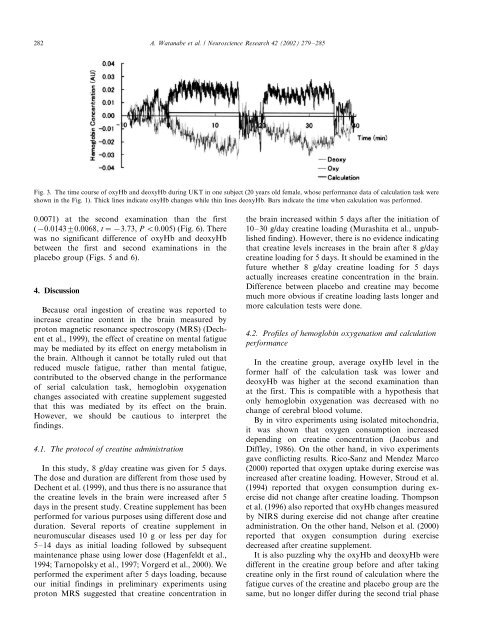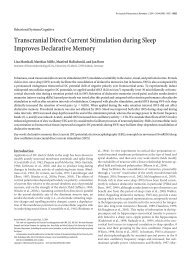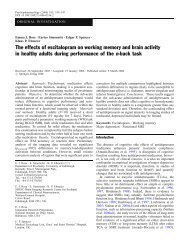Watanabe 2002 - AMA-Marketing
Watanabe 2002 - AMA-Marketing
Watanabe 2002 - AMA-Marketing
You also want an ePaper? Increase the reach of your titles
YUMPU automatically turns print PDFs into web optimized ePapers that Google loves.
282<br />
A. <strong>Watanabe</strong> et al. / Neuroscience Research 42 (<strong>2002</strong>) 279/285<br />
Fig. 3. The time course of oxyHb and deoxyHb during UKT in one subject (20 years old female, whose performance data of calculation task were<br />
shown in the Fig. 1). Thick lines indicate oxyHb changes while thin lines deoxyHb. Bars indicate the time when calculation was performed.<br />
0.0071) at the second examination than the first<br />
(/0.01439/0.0068, t//3.73, P B/0.005) (Fig. 6). There<br />
was no significant difference of oxyHb and deoxyHb<br />
between the first and second examinations in the<br />
placebo group (Figs. 5 and 6).<br />
4. Discussion<br />
Because oral ingestion of creatine was reported to<br />
increase creatine content in the brain measured by<br />
proton magnetic resonance spectroscopy (MRS) (Dechent<br />
et al., 1999), the effect of creatine on mental fatigue<br />
may be mediated by its effect on energy metabolism in<br />
the brain. Although it cannot be totally ruled out that<br />
reduced muscle fatigue, rather than mental fatigue,<br />
contributed to the observed change in the performance<br />
of serial calculation task, hemoglobin oxygenation<br />
changes associated with creatine supplement suggested<br />
that this was mediated by its effect on the brain.<br />
However, we should be cautious to interpret the<br />
findings.<br />
4.1. The protocol of creatine administration<br />
In this study, 8 g/day creatine was given for 5 days.<br />
The dose and duration are different from those used by<br />
Dechent et al. (1999), and thus there is no assurance that<br />
the creatine levels in the brain were increased after 5<br />
days in the present study. Creatine supplement has been<br />
performed for various purposes using different dose and<br />
duration. Several reports of creatine supplement in<br />
neuromuscular diseases used 10 g or less per day for<br />
5/14 days as initial loading followed by subsequent<br />
maintenance phase using lower dose (Hagenfeldt et al.,<br />
1994; Tarnopolsky et al., 1997; Vorgerd et al., 2000). We<br />
performed the experiment after 5 days loading, because<br />
our initial findings in preliminary experiments using<br />
proton MRS suggested that creatine concentration in<br />
the brain increased within 5 days after the initiation of<br />
10/30 g/day creatine loading (Murashita et al., unpublished<br />
finding). However, there is no evidence indicating<br />
that creatine levels increases in the brain after 8 g/day<br />
creatine loading for 5 days. It should be examined in the<br />
future whether 8 g/day creatine loading for 5 days<br />
actually increases creatine concentration in the brain.<br />
Difference between placebo and creatine may become<br />
much more obvious if creatine loading lasts longer and<br />
more calculation tests were done.<br />
4.2. Profiles of hemoglobin oxygenation and calculation<br />
performance<br />
In the creatine group, average oxyHb level in the<br />
former half of the calculation task was lower and<br />
deoxyHb was higher at the second examination than<br />
at the first. This is compatible with a hypothesis that<br />
only hemoglobin oxygenation was decreased with no<br />
change of cerebral blood volume.<br />
By in vitro experiments using isolated mitochondria,<br />
it was shown that oxygen consumption increased<br />
depending on creatine concentration (Jacobus and<br />
Diffley, 1986). On the other hand, in vivo experiments<br />
gave conflicting results. Rico-Sanz and Mendez Marco<br />
(2000) reported that oxygen uptake during exercise was<br />
increased after creatine loading. However, Stroud et al.<br />
(1994) reported that oxygen consumption during exercise<br />
did not change after creatine loading. Thompson<br />
et al. (1996) also reported that oxyHb changes measured<br />
by NIRS during exercise did not change after creatine<br />
administration. On the other hand, Nelson et al. (2000)<br />
reported that oxygen consumption during exercise<br />
decreased after creatine supplement.<br />
It is also puzzling why the oxyHb and deoxyHb were<br />
different in the creatine group before and after taking<br />
creatine only in the first round of calculation where the<br />
fatigue curves of the creatine and placebo group are the<br />
same, but no longer differ during the second trial phase




